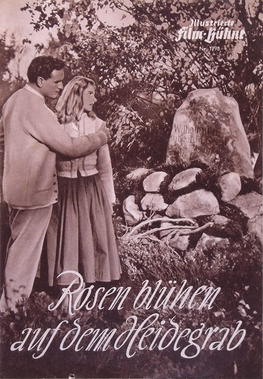Plot
This article needs a plot summary.(March 2024) |
| Cavalcade | |
|---|---|
| Directed by | Albert Arliss Richard von Schenk |
| Written by | Albert Arliss José Ramón Luna |
| Produced by | Tonino Cervi Robert Philippi |
| Starring | Ruth Niehaus Helmuth Schneider Félix Tortorelli |
| Cinematography | Luis Galán de Tierra |
| Edited by | Vicente Castagno Adolf Schlyssleder |
| Music by | George Andreani Frank Fox |
Release date |
|
| Country | Argentina |
| Language | Spanish |
Cavalcade is a 1960 Argentine film directed by Albert Arliss and Richard von Schenk and starring Ruth Niehaus and Helmuth Schneider. [1]
This article needs a plot summary.(March 2024) |

May Ruth Snyder was an American murderer. Her execution in the electric chair at New York's Sing Sing Prison in 1928 for the murder of her husband, Albert Snyder, was recorded in a highly publicized photograph.

Helmuth Schneider was a German actor.
Herodorus, also called Herodorus of Heraclea was a native of Heraclea Pontica and wrote a history on Heracles around 400 BC. Plutarch references Herodorus several times in his account of Theseus in Parallel Lives. He is among the authors whose fragments were collected in Felix Jacoby's Fragmente der griechischen Historiker.

Travellers in Space and Time is the seventh studio album by The Apples in Stereo released in 2010. It was the first album by the band to feature new drummer John Dufilho, as well as the first to cite Bill Doss and John Ferguson as permanent band members. It is heavily influenced by the Electric Light Orchestra, especially their science-fiction concept album Time.
Adalbert Kraus is a German tenor in opera and concert, known for singing the works of Johann Sebastian Bach.

Hollywood Cavalcade is a 1939 American film featuring Alice Faye as a young performer making her way in the early days of Hollywood, from slapstick silent pictures through the transition from silent to sound.

The House in Montevideo is a 1951 West German comedy film directed by Curt Goetz and Valérie von Martens and starring Goetz, von Martens, Albert Florath and Lia Eibenschütz. It is an adaptation of Goetz's 1945 comic play The House in Montevideo. Goetz and von Martens had frequently played the lead parts on the stage. The play was later adapted into another film of the same title in 1963.
Ruth Hildegard Rosemarie Niehaus (1925–1994) was a German stage and film actress.
Ruth Sandhoff is a German classically trained mezzo-soprano. Her concert repertory ranges from early Baroque to contemporary music, with a special fondness for lieder.

A Thousand Melodies is a 1956 West German musical film directed by Hans Deppe and starring Martin Benrath, Gardy Granass and Helmuth Schneider.
Urlaub auf Ehrenwort is a 1955 West German drama film directed by Wolfgang Liebeneiner and starring Claus Biederstaedt, Eva Ingeborg Scholz and Reinhard Kolldehoff. It is a remake of the 1939 film Urlaub auf Ehrenwort about German soldiers granted leave during the Second World War.

The House of Three Girls is a 1958 Austrian-West German musical film directed by Ernst Marischka and starring Karlheinz Böhm, Rudolf Schock and Magda Schneider. It is based on the operetta Das Dreimäderlhaus. The story had previously been made into the film Three Girls for Schubert in 1936.

Roses Bloom on the Moorland is a 1952 West German drama film directed by Hans H. König and starring Ruth Niehaus, Hermann Schomberg and Armin Dahlen. It is also known in English by the alternative titles Rape on the Moor and Roses Bloom on the Grave in the Heather.

No Way Back is a 1953 West German drama film directed by Victor Vicas and starring Ivan Desny, Ruth Niehaus and René Deltgen. It was made at the height of the Cold War.

The Mill in the Black Forest is a 1953 West German drama film directed by Hermann Kugelstadt and starring Edith Mill, Helmuth Schneider and Albert Hehn. It was shot at the Bavaria Studios in Munich. The film's sets were designed by the art director Max Seefelder. Location shooting took place at Furtwangen in the Black Forest and Bingen on the Rhine.

The Fisherman from Heiligensee is a 1955 West German romantic comedy film directed by Hans H. König and starring Edith Mill, Lil Dagover and Albert Lieven. It was part of the post-war boom in heimatfilm pictures in Germany.

Annie from Tharau is a 1954 West German romance film directed by Wolfgang Schleif and starring Ilse Werner, Heinz Engelmann, Helmuth Schneider. It takes its name from a historic song of the same title and was part of the post-war heimatfilm genre in German cinema.
Oliver P. Morton is a 1900 marble statue of Governor Oliver P. Morton by Charles Henry Niehaus installed in the United States Capitol, in Washington, D.C., as part of the National Statuary Hall Collection. It is one of two statues donated by the state of Indiana. The statue was accepted into the collection on April 14, 1900, by Indiana Senator Albert J. Beveridge.

Three Birch Trees on the Heath is a 1956 West German drama film directed by Ulrich Erfurth and starring Margit Saad, Sonja Sutter and Helmuth Schneider. It was one of 54 heimatfilm pictures produced that year, as the genre's popularity reached its peak.

The Forest House in Tyrol or The Lodge in Tyrol is a 1955 West German drama film directed by Hermann Kugelstadt and starring Wera Frydtberg, Helmuth Schneider and Dorothea Wieck. Location shooting took place around Mittenwald, Innsbruck and Kitzbühel. Interiors were shot at temporary studio in Mittenwald. The film's sets were designed by the art director Max Seefelder. It was part of the boom in heimatfilm pictures in post-war West Germany.